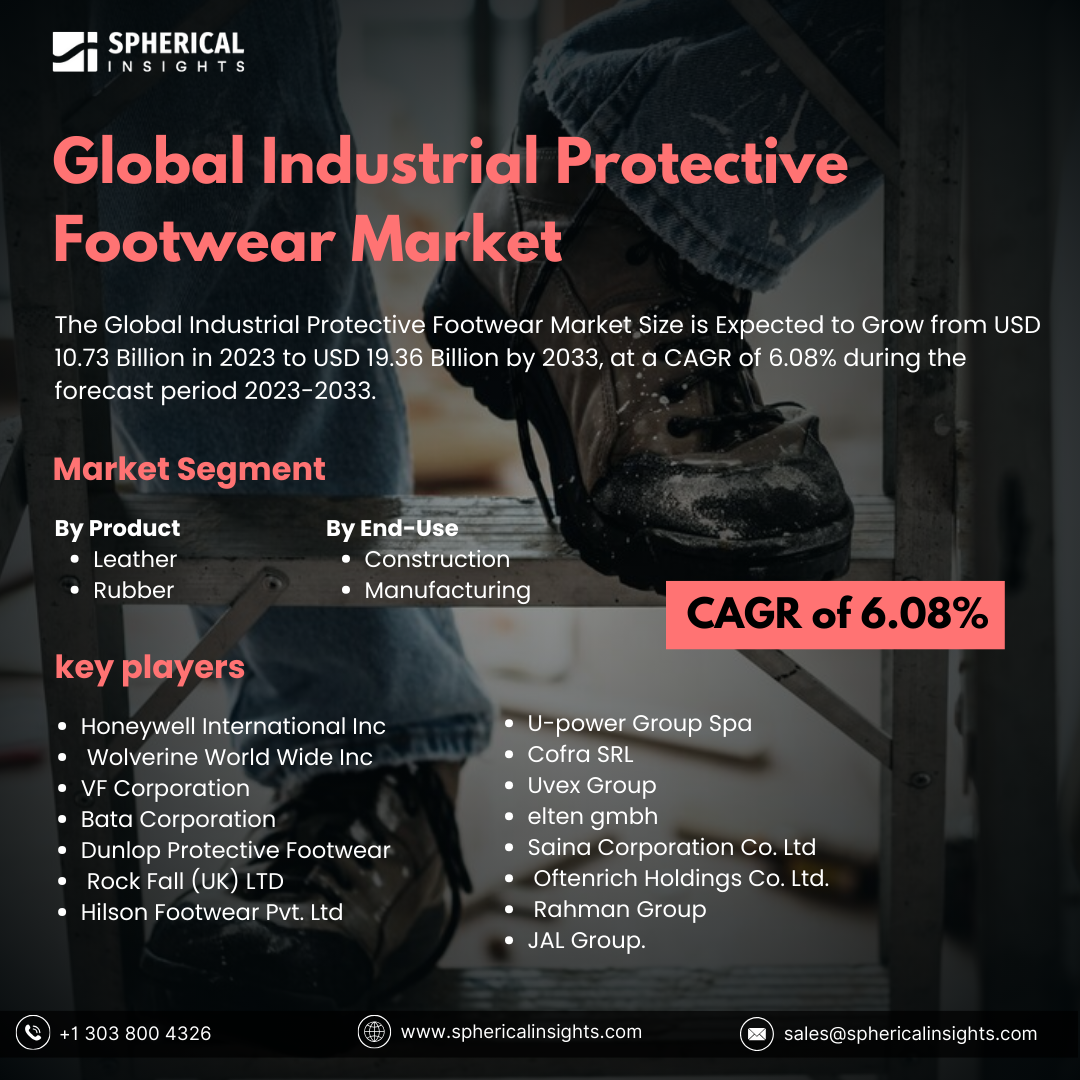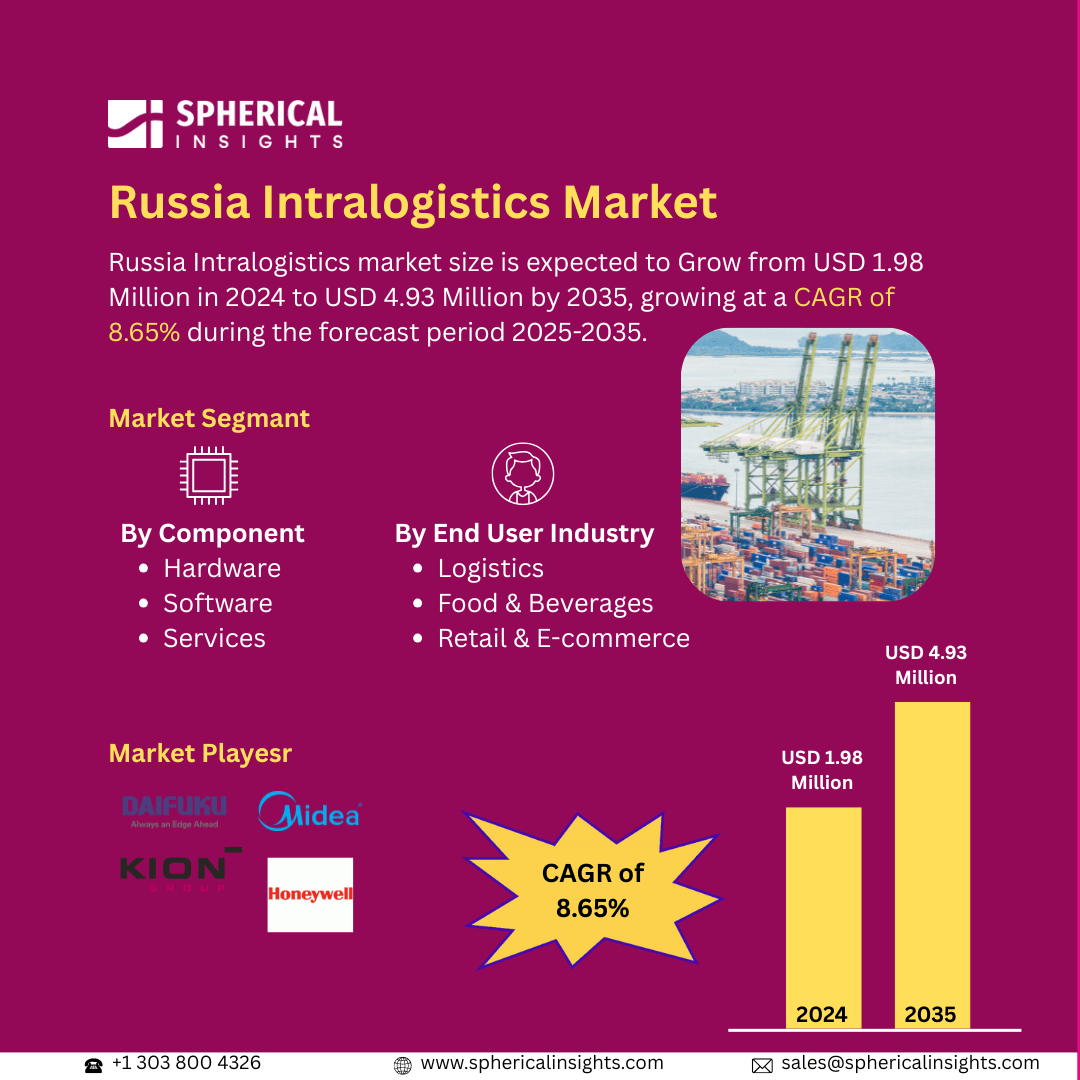Global Industrial Protective Footwear Market Size to worth USD 19.36 Billion by 2033
According to a research report published by Spherical Insights & Consulting, the Global Industrial Protective Footwear Market Size is Expected to Grow from USD 10.73 Billion in 2023 to USD 19.36 Billion by 2033, at a CAGR of 6.08% during the forecast period 2023-2033.
Browse key industry insights spread across 210 pages with 110 Market data tables and figures & charts from the report on the Global Industrial Protective Footwear Market Size, Share, and COVID-19 Impact Analysis, By Product (Leather and Rubber), By End-Use (Construction and Manufacturing), and By Region (North America, Europe, Asia-Pacific, Latin America, Middle East, and Africa), Analysis and Forecast 2023 – 2033.
Industrial protective footwear is the safety shoes, boots, and other types of footwear designed to protect workers' feet from a variety of hazards in industrial environments. These hazards include falling objects, sharp materials, chemical spills, electrical hazards, and extreme temperatures. The footwear is engineered to meet specific safety standards and provide comfort, durability, and functionality to ensure worker safety in high-risk industries such as construction, manufacturing, mining, and oil and gas. Furthermore, the growing concern for worker safety and rising awareness of occupational health hazards are the primary factors driving the industrial protective footwear market. Strict government regulations and safety standards are also motivating industries to adopt protective footwear as a mandatory measure. Furthermore, the development of manufacturing and construction sectors in emerging economies is leading to an increased demand for protective footwear. The introduction of advanced technologies in material design like lightweight yet durable materials increased the comfort and performance capabilities of industrial footwear, opening it up to a wide consumer base. However, the high cost of quality industrial protective footwear may present challenges in the market, and such might discourage small and medium-sized enterprises from investing in safety footwear.
The leather segment is predicted to hold the greatest market share through the forecast period.
Based on the product, the industrial protective footwear market is classified into leather and rubber. Among these, the leather segment is predicted to hold the greatest market share through the forecast period. This can be attributed to the Leather footwear is widely preferred in industrial environments because of its durability, comfort, and ability to protect against a variety of hazards such as sharp objects, heavy impacts, and extreme temperatures. Leather offers a combination of flexibility and strength, making it ideal for industries such as construction, mining, and manufacturing, where workers are exposed to harsh conditions.
The construction segment is anticipated to hold the greatest market share during the projected timeframe.
Based on the end-use, the industrial protective footwear market is divided into construction and manufacturing. Among these, the construction segment is anticipated to hold the greatest market share during the projected timeframe. This is because the construction industry is very risky and has workers exposed to many hazardous conditions, including falling objects, sharp materials, heavy machinery, and uneven terrain. As such, there is always a demand for strong and protective footwear, such as steel-toe boots and safety shoes, in this industry.
North America is estimated to hold the largest share of the industrial protective footwear market over the forecast period.
North America is estimated to hold the largest share of the industrial protective footwear market over the forecast period. This is because the construction industry is very risky and has workers exposed to many hazardous conditions, including falling objects, sharp materials, heavy machinery, and uneven terrain. As such, there is always a demand for strong and protective footwear, such as steel-toe boots and safety shoes, in this industry.
Asia-Pacific is predicted to have the fastest CAGR growth in the industrial protective footwear market over the forecast period. The APAC region is witnessing significant industrial development. This includes countries such as China, India, and South East Asian nations. Rising demand for protective footwear from the growing industries of construction, manufacturing, and mining creates an increased need for safety gear at the workplace.
Company Profiling
Major key players in the industrial protective footwear market are Honeywell International Inc., Wolverine World Wide Inc, VF Corporation, Bata Corporation, Dunlop Protective Footwear, Rock Fall (UK) LTD, Hilson Footwear Pvt. Ltd, U-power Group Spa, Cofra SRL, Uvex Group, elten gmbh, Saina Corporation Co. Ltd, Oftenrich Holdings Co. Ltd., Rahman Group, and JAL Group.
Key Target Audience
- Market Players
- Investors
- End-users
- Government Authorities
- Consulting And Research Firm
- Venture capitalists
- Value-Added Resellers (VARs)
Recent Development
- In July 2024, Cat Footwear launched the Invader Mid Vent, which highlights a variety of advanced features. These include a ReViveTech Engineered Comfort footbed, a lining made entirely from post-industrial recycled materials with an NXT footbed cover, a resilient EVA midsole, a sturdy nylon shank, a composite toe cap for enhanced protection, and a rugged industrial-grade rubber outsole.
Market Segment
This study forecasts global, regional, and country revenue from 2023 to 2033. Spherical Insights has segmented the industrial protective footwear market based on the below-mentioned segments:
Global Industrial Protective Footwear Market, By Product
Global Industrial Protective Footwear Market, By End-Use
- Construction
- Manufacturing
Global Industrial Protective Footwear Market, By Regional Analysis
- North America
- Europe
- Germany
- UK
- France
- Italy
- Spain
- Russia
- Rest of Europe
- Asia Pacific
- China
- Japan
- India
- South Korea
- Australia
- Rest of Asia Pacific
- South America
- Brazil
- Argentina
- Rest of South America
- Middle East & Africa
- UAE
- Saudi Arabia
- Qatar
- South Africa
- Rest of the Middle East & Africa



